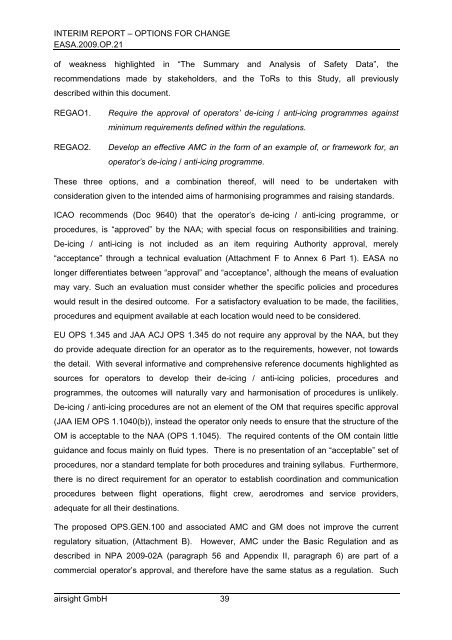Interim Report - Introduction - EASA
Interim Report - Introduction - EASA
Interim Report - Introduction - EASA
You also want an ePaper? Increase the reach of your titles
YUMPU automatically turns print PDFs into web optimized ePapers that Google loves.
INTERIM REPORT – OPTIONS FOR CHANGE<br />
<strong>EASA</strong>.2009.OP.21<br />
of weakness highlighted in “The Summary and Analysis of Safety Data”, the<br />
recommendations made by stakeholders, and the ToRs to this Study, all previously<br />
described within this document.<br />
REGAO1. Require the approval of operators’ de-icing / anti-icing programmes against<br />
minimum requirements defined within the regulations.<br />
REGAO2. Develop an effective AMC in the form of an example of, or framework for, an<br />
operator’s de-icing / anti-icing programme.<br />
These three options, and a combination thereof, will need to be undertaken with<br />
consideration given to the intended aims of harmonising programmes and raising standards.<br />
ICAO recommends (Doc 9640) that the operator’s de-icing / anti-icing programme, or<br />
procedures, is “approved” by the NAA; with special focus on responsibilities and training.<br />
De-icing / anti-icing is not included as an item requiring Authority approval, merely<br />
“acceptance” through a technical evaluation (Attachment F to Annex 6 Part 1). <strong>EASA</strong> no<br />
longer differentiates between “approval” and “acceptance”, although the means of evaluation<br />
may vary. Such an evaluation must consider whether the specific policies and procedures<br />
would result in the desired outcome. For a satisfactory evaluation to be made, the facilities,<br />
procedures and equipment available at each location would need to be considered.<br />
EU OPS 1.345 and JAA ACJ OPS 1.345 do not require any approval by the NAA, but they<br />
do provide adequate direction for an operator as to the requirements, however, not towards<br />
the detail. With several informative and comprehensive reference documents highlighted as<br />
sources for operators to develop their de-icing / anti-icing policies, procedures and<br />
programmes, the outcomes will naturally vary and harmonisation of procedures is unlikely.<br />
De-icing / anti-icing procedures are not an element of the OM that requires specific approval<br />
(JAA IEM OPS 1.1040(b)), instead the operator only needs to ensure that the structure of the<br />
OM is acceptable to the NAA (OPS 1.1045). The required contents of the OM contain little<br />
guidance and focus mainly on fluid types. There is no presentation of an “acceptable” set of<br />
procedures, nor a standard template for both procedures and training syllabus. Furthermore,<br />
there is no direct requirement for an operator to establish coordination and communication<br />
procedures between flight operations, flight crew, aerodromes and service providers,<br />
adequate for all their destinations.<br />
The proposed OPS.GEN.100 and associated AMC and GM does not improve the current<br />
regulatory situation, (Attachment B). However, AMC under the Basic Regulation and as<br />
described in NPA 2009-02A (paragraph 56 and Appendix II, paragraph 6) are part of a<br />
commercial operator’s approval, and therefore have the same status as a regulation. Such<br />
airsight GmbH 39

















